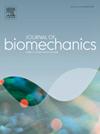Comparison between the fluid–structure interaction approach and the finite element method approach to analyze the leaflet flutter in bioprosthetic aortic valve
IF 2.4
3区 医学
Q3 BIOPHYSICS
引用次数: 0
Abstract
The low durability of bioprosthetic heart valves (BHV), between 10-15 years, is associated with the development of leaflets flutter. Despite increasing calcification and structural damage of the BHV, leaflets flutter is an understudied condition. Therefore, the objective of this study is compare the oscillation characteristics of BHV leaflets obtained by the finite element method (FEM) technique and by the fluid-structural interaction (FSI) technique. A BHV geometry and a simplified fluid domain were developed. Physiological ventricular and aortic pressure were applied in the FEM and FSI simulations. The BHV were considered with incompressible hyperelastic and isotropic mechanical behavior, while the blood was modeled as a Newtonian fluid. Turbulence was modeled according to the k – SST model. The displacement and maximum principal stress results showed that the FSI approach was in better agreement with the in vitro studies in the literature. Furthermore, the leaflet vibration frequency was 12 times lower and the amplitude 50 times higher compared to the FEM method. From the stress distribution in the leaflets, the highest values occurred in the commissure region of the ventricular side for both techniques. In addition, while the stress was more uniform for FEM, FSI showed a stress concentration in the belly region of the leaflets. This study indicates that the use of the FEM technique to assess fatigue intensification due to leaflet fluttering could induce inaccurate conclusions, since it does not incorporate the dynamic fluid impacts on leaflets.
求助全文
约1分钟内获得全文
求助全文
来源期刊

Journal of biomechanics
生物-工程:生物医学
CiteScore
5.10
自引率
4.20%
发文量
345
审稿时长
1 months
期刊介绍:
The Journal of Biomechanics publishes reports of original and substantial findings using the principles of mechanics to explore biological problems. Analytical, as well as experimental papers may be submitted, and the journal accepts original articles, surveys and perspective articles (usually by Editorial invitation only), book reviews and letters to the Editor. The criteria for acceptance of manuscripts include excellence, novelty, significance, clarity, conciseness and interest to the readership.
Papers published in the journal may cover a wide range of topics in biomechanics, including, but not limited to:
-Fundamental Topics - Biomechanics of the musculoskeletal, cardiovascular, and respiratory systems, mechanics of hard and soft tissues, biofluid mechanics, mechanics of prostheses and implant-tissue interfaces, mechanics of cells.
-Cardiovascular and Respiratory Biomechanics - Mechanics of blood-flow, air-flow, mechanics of the soft tissues, flow-tissue or flow-prosthesis interactions.
-Cell Biomechanics - Biomechanic analyses of cells, membranes and sub-cellular structures; the relationship of the mechanical environment to cell and tissue response.
-Dental Biomechanics - Design and analysis of dental tissues and prostheses, mechanics of chewing.
-Functional Tissue Engineering - The role of biomechanical factors in engineered tissue replacements and regenerative medicine.
-Injury Biomechanics - Mechanics of impact and trauma, dynamics of man-machine interaction.
-Molecular Biomechanics - Mechanical analyses of biomolecules.
-Orthopedic Biomechanics - Mechanics of fracture and fracture fixation, mechanics of implants and implant fixation, mechanics of bones and joints, wear of natural and artificial joints.
-Rehabilitation Biomechanics - Analyses of gait, mechanics of prosthetics and orthotics.
-Sports Biomechanics - Mechanical analyses of sports performance.
 求助内容:
求助内容: 应助结果提醒方式:
应助结果提醒方式:


